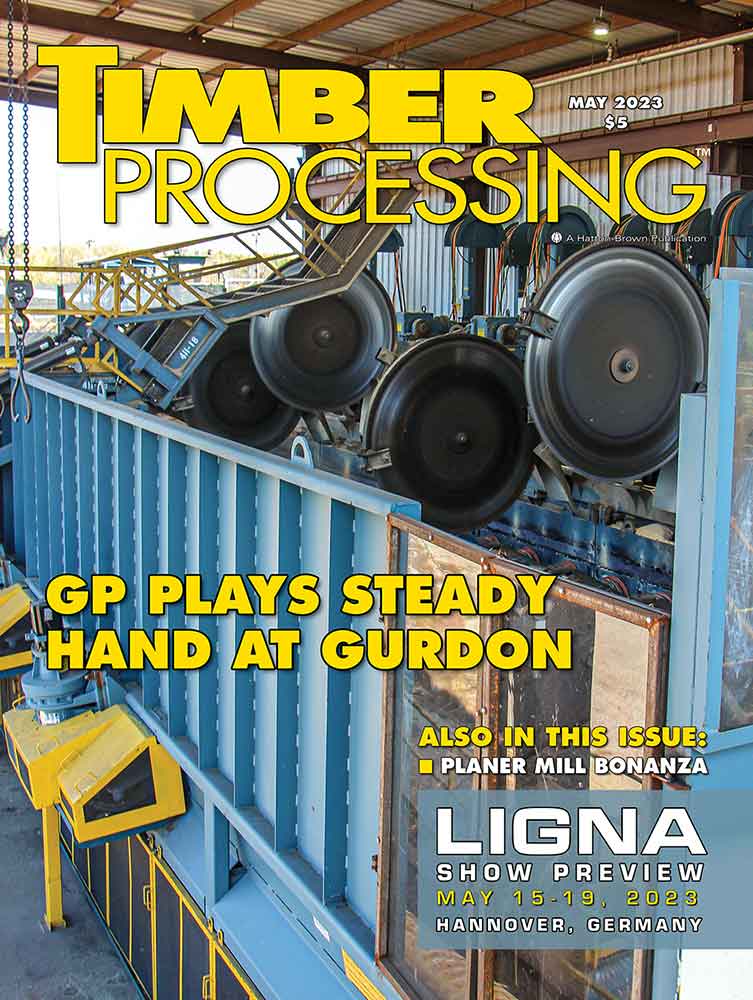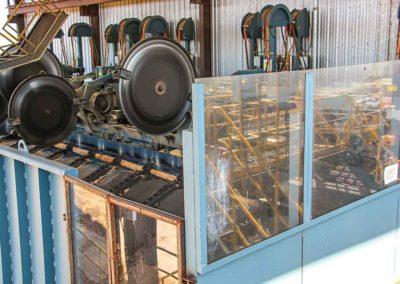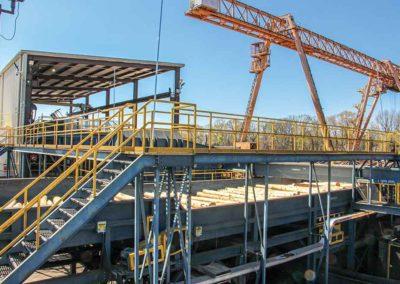MAY 2023
Cover: GP Plays Steady Hand At Gurdon
GURDON, Arkansas – Like many manufacturing complexes of a certain age, Georgia-Pacific’s Gurdon site serves multiple purposes. Having started out solely as a plywood plant with a hog making chips for paper, the site has come a long way in its history. The sawmill was an afterthought, built so buyers could get wood cheaper.
Inside This Issue
THE ISSUES: Lumbering Along With James Oliver Dunn
Some of my very first memories are playing around my grandmother’s house located on a country road in Brushy Creek, Alabama, which is a suburb of East Chapman, which is no longer a town but primarily the Boise Cascade Chapman mill site, though the small community around it clings tenaciously to the tiny post office out on Hwy. 31. In fact, the county road where my father grew up dead-ended into the W.T. Smith Lumber Co. log yard, and both sides of my family had various relationships with the mill and its owners that go back well over 100 years.
Article by Dan Shell, Senior Editor, Timber Processing
NEWSfeed
- TP&EE Show Dates Set For 2024
- SYP Shipments Shatter Records
- Byproducts Look To Pellet Mills
- Roseburg Announces Massive Investment
Ligna
EDITOR’S NOTE: The following companies submitted editorial profiles to complement their advertisements in Timber Processing May 2023.
- Barton Maquinaria
- Brunner-Hildebrand
- Carbotech
- CERATIZIT
- Combilift
- Dynalyse
- Easy-Laser
- Gilbert
- Grenzebach
- Hatton-Brown Publishers
- JoeScan
- Ledinek
- LINCK
- Mebor
- Mendes
- MiCROTEC
- MINDA
- Mühlböck
- PRINZ
- Springer
- Stenner
- USNR
- Valutec
- Weinig
- WeMa
- Probst
- Wood-Mizer
Singing The Blues: The History Of Turpentine
Third of Three Parts
At its very best, logging work was tough, exhausting and dangerous in early America and through the first half of the 20th century, but by most historical accounts, conditions were tougher, in some instances downright cruel, for those who toiled in the gum turpentine woods. The dirty, sticky, ‘can to can’t’ work regimen was a grueling treadmill, given its tree-to-tree walking requirement, at times through thick brush, mud, or standing water. While heavy, the tools used for tree chipping were light compared with gum buckets, which could weigh 50 lbs. when full. Throw in searing heat, stifling humidity, hordes of mosquitoes and other insects, and the always there snake threat. Add high quotas imposed by demanding camp bosses and enforced by mounted woods riders, who could be ruthless.
Article by DK Knight, Editor/Publisher Emeritus
Planer Mill Bonanza
EDITOR’S NOTE: The following companies submitted editorial profiles to complement their advertisements in Timber Processing May 2023.
- BID Group
- Carbotech
- Delmhorst
- Dynalyse
- Gilbert
- Hogue Industries
- Mellott Manufacturing
- Murray Latta
- PICHÉ
- Springer
- USNR
- Wolftek
- Wood-Mizer
MACHINERYrow
- Greentree Upgrades Primary Breakdown
- Combilift Contributes To Convoy Of Hope
- Forest Pro Adds DEVELON Lineup
- WMF Returns To Shanghai
- Arxada Teams With ICONX
- Bandit Industries Continues Growth
ATlarge
- Binderholz Celebrates Sawmill Opening
- Hardwood Manufacturers Association Elects Petzoldt As President
- New Europe Coalition Focuses On Bioeconomy
- Mercer Holz Launches German Forests Program
Find Us On Social
GP Plays Steady Hand At Gurdon
Article by Jessica Johnson, Senior Editor, Timber Processing
GURDON, Arkansas – Like many manufacturing complexes of a certain age, Georgia-Pacific’s Gurdon site serves multiple purposes. Having started out solely as a plywood plant with a hog making chips for paper, the site has come a long way in its history. The sawmill was an afterthought, built so buyers could get wood cheaper. As the industry, GP and the markets have changed since 1978, so has Gurdon Lumber. Gone are the days the facility just subsidizes its plywood big brother with a single shift. Now, the 230MMBF two-shift sawmill shines on its own—including a large infusion of capital designed to help both mills run better.
Though the sawmill has stepped into the sun, it still has some remains of its humble beginnings, which include the shared wood yard. For 15 years, Mill Manager Mike Hamill says Gurdon Lumber has been on a journey to improve. A planer project in 2015 really reinvigorated production rates. But, still the mill struggled. The bottleneck was the wood yard. Having to feed both fully operational sites put a lot of stress on the vintage equipment. So, as 33-year Gurdon veteran (and Wood Yard Superintendent) George Boyette says, the third time was the charm. After completing plans and working with vendors not once, not twice, but three times, Gurdon got the go ahead and awarded Comact, through BID Group, a merchandiser line project in 2020.
This new merchandiser had a tall order feeding both, but it replaced a machine that had originally been installed to help cut pulpwood for a drum debarker to ultimately make paper chips. A huge driver of the project was the possibility of what the sawmill could produce if it had the right tools. Hamill says that the timing of the project was really good for the mill, and the mill was able to lean heavily on its veterans to help with smoothing out project completion wrinkles.
“The industry skill sets are diminishing,” he adds. “You don’t have a lot of people that have been at the same facility for 30 or 40 years. Despite the loss of long-tenured employees, we had a successful startup. In fact, it was probably one of our best projects.”
Want More Content?
Timber Processing magazine is delivered 11 times per year to subscribers, who represent sawmill ownership, management and supervisory personnel and corporate executives.
Newsletter
The monthly Timber Processing Industry Newsletter reaches over 4,000 mill owners and supervisors.
Subscribe/Renew
Timber Processing is delivered 10 times per year to subscribers who represent sawmill ownership, management and supervisory personnel and corporate executives. Subscriptions are FREE to qualified individuals.
Advertise
Complete the online form so we can direct you to the appropriate Sales Representative.



